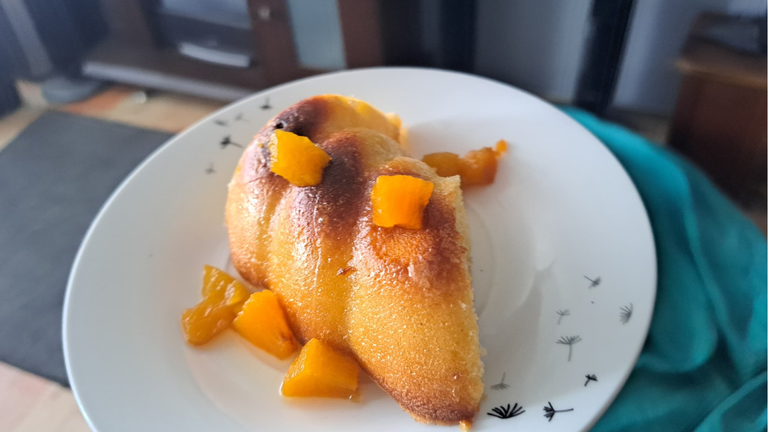
Dicen que todos los caminos dan a Roma, y no hay nada más cierto que esta frase, pues en la vida tenemos múltiples maneras de hacer algo y obtener un buen resultado. Recuerdo que en mis años mozos una de mis tías hacía pasteles o, como les llaman aquí en Venezuela, tortas. El método que utilizaba en ese entonces consistía en separar las claras de las yemas, batirlas con el azúcar hasta obtener una crema, batir las claras a punto de nieve. Agregar los ingredientes secos a la mezcla de yemas intercalando con la leche, para finalizar agregando las claras batidas con movimientos envolventes.
Con el pasar de los años también vi diferencias en su forma de hacer pasteles, ya no separaba claras de yemas, sino que agregaba los huevos uno a uno a la mezcla. Y llegó el momento en que ya dominaba tan bien la mezcla que prácticamente colocaba casi todos los ingredientes juntos en la batidora.
Recuerdo que hace varios años me topé con un video que me pareció bastante extraño. La creadora de contenido iba a hacer un pastel y lo primero que hizo fue batir la harina de trigo con la mantequilla, luego incorporó el azúcar, los huevos y, por último, la harina y la leche intercaladas. Me animé a hacer esa receta y al día de hoy no puedo creer lo esponjosa que queda esta preparación, así el método invertido resume mucho más los pasos para preparar un pastel.
Hace pocos días vi otra forma de hacer pasteles que me dejó impactada. El procedimiento es aún más fácil y el resultado es estupendo, así que te adelanto que el método de cremado/batido inverso se ha vuelto mi favorito para hacer pasteles de vainilla.
¡Y ahora vamos a ponernos el delantal!+
They say that all roads lead to Rome, and there is nothing truer than this phrase, because in life we have multiple ways to do something and get a good result. I remember in my younger years one of my aunts used to make cakes or, as they are called here in Venezuela, tortas. The method she used back then consisted of separating the egg whites from the egg yolks, beat them with the sugar until you get a cream, beat the egg whites until stiff. Add the dry ingredients to the egg yolk mixture, alternating them with the milk, and finally add the beaten egg whites in an enveloping motion.
As the years went by I also saw differences in her way of making cakes, she no longer separated the egg whites from the yolks, but added the eggs one by one to the mixture. And the time came when she had mastered the mixture so well that she practically put almost all the ingredients together in the mixer.
I remember several years ago I came across a video that struck me as rather strange. The content creator was going to make a cake and the first thing she did was to beat the wheat flour with the butter, then she incorporated the sugar, the eggs and finally the flour and milk interspersed. I was encouraged to make that recipe and to this day I can't believe how fluffy this preparation is, so the inverted method summarizes much more the steps to prepare a cake.
A few days ago I saw another way to make cakes that blew me away. The procedure is even easier and the result is great, so I'm telling you that the reverse creaming/whipping method has become my favorite for making vanilla cakes.
Ingredientes (Ingredients)
- 1 y 1/2 tazas de harina leudante.
- 1/2 taza de mantequilla.
- 1 taza de azúcar (Esta receta la repetí usando 1/2 de azúcar y funcionó muy bien).
- 2 huevos.
- 1/2 taza de leche.
- 1 y 1/2 cucharadita de polvo de hornear.
- 1 and 1/2 cups of leavening flour.
- 1/2 cup butter.
- 1 cup of sugar (I repeated this recipe using 1/2 of sugar and it worked very well).
- 2 eggs.
- 1/2 cup milk.
- 1 and 1/2 teaspoon of baking powder.
Preparación (How to make it)
- El primer paso consiste en colocar todos los ingredientes secos en un bol. En la foto puedes ver la mantequilla sobresalir de la harina, pero yo la aplasté un poco y la cubrí con harina. Usé una batidora de varillas a velocidad baja para evitar que la harina saliera volando. Fui aumentando la velocidad a medida que mezclaba estos ingredientes.
The first step is to place all the dry ingredients in a bowl. In the photo you can see the butter sticking out of the flour, but I flattened it a bit and covered it with flour. I used a stick mixer on low speed to prevent the flour from flying out. I increased the speed as I mixed these ingredients.
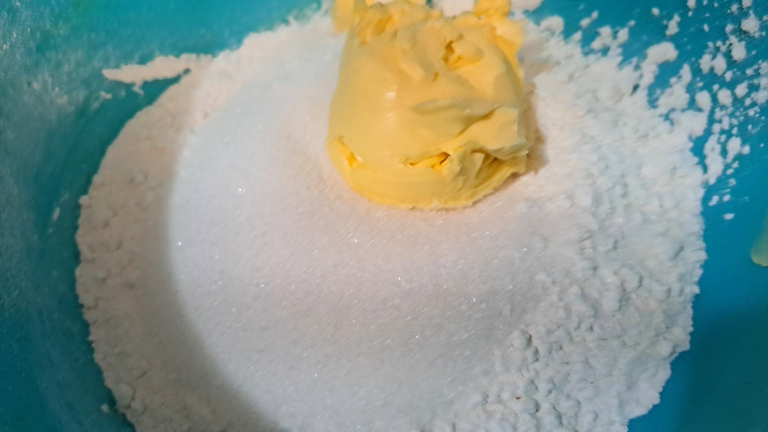
- Se baten los ingredientes secos hasta obtener una mezcla con textura arenosa.
The first step is to place all the dry ingredients in a bowl. In the photo, you can see the butter sticking out of the flour, but I flattened it slightly and covered it with more flour. I used a stick mixer on low speed to prevent the flour from flying out. I increased the speed as I mixed these ingredients.
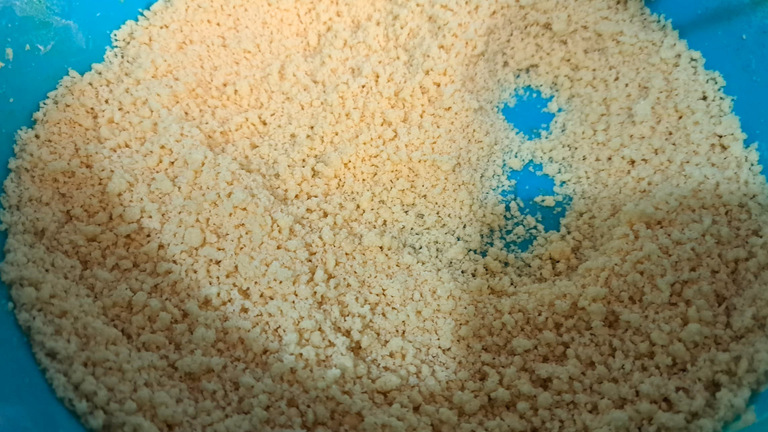
- Por otra parte, se mezclan muy bien los ingredientes líquidos.
On the other hand, the liquid ingredients are mixed very well.
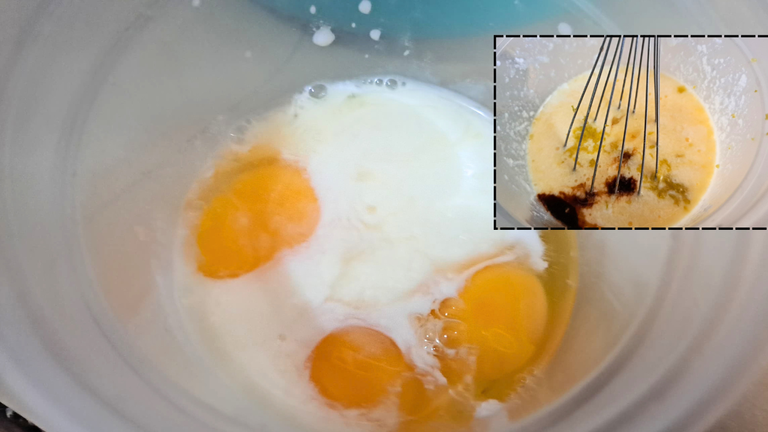
- Se agregan los ingredientes líquidos a la mezcla con textura arenosa y se bate para unificar.
Add the liquid ingredients to the mixture with a sandy texture and whisk to unify.
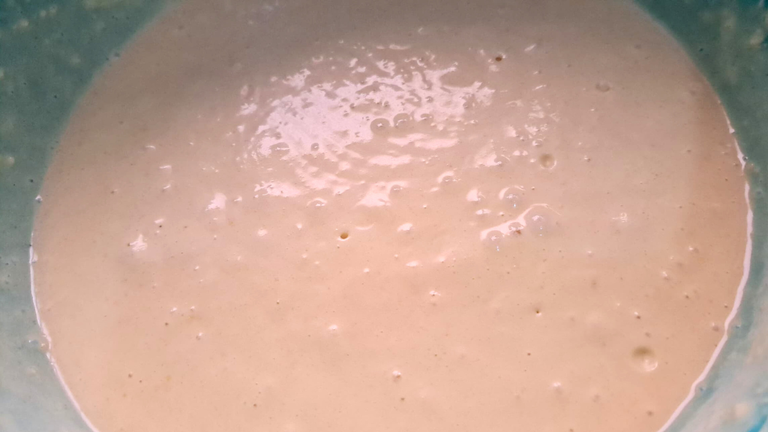
- Coloca la mezcla en el molde de tu preferencia. Esta mezcla también te servirá para hacer cupcakes, si así lo deseas. Lleva al horno precalentado a 180 grados centígrados durante 40 minutos. Recuerda que el tiempo de cocción dependerá de tu horno.
Place the mixture in the mold of your choice. This mixture can also be used to make cupcakes, if desired. Bake in a preheated oven at 180 degrees Celsius for 40 minutes. Remember that the baking time will depend on your oven.
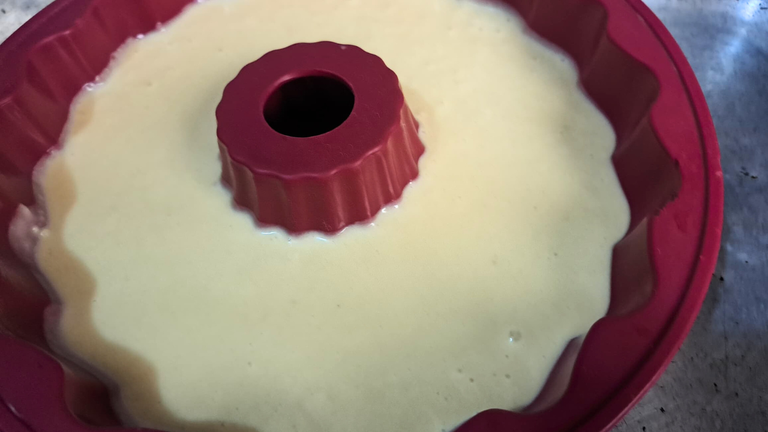
- Quedó muy rico y esponjoso, lo bañé con almíbar de durazno casero y trocitos de durazno cocidos en ese almíbar.
It turned out very rich and fluffy; I bathed it with homemade peach syrup and topped it with peach pieces cooked in that syrup.
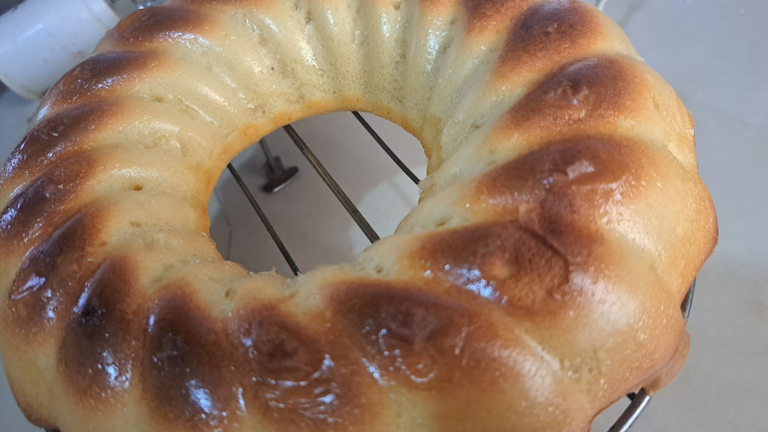
Después de haber probado este método de cremado inverso, encuentro que es la forma más sencilla para hacer un pastel, e incluso considero que es un método a prueba de fallas. No creo que consiga otra manera más sencilla para hacer un pastel y que funcione tan bien. ¡Esta ya se volvió mi forma favorita de preparar pastel de vainilla!
Having tried this reverse creaming method, I find it to be the easiest way to make a cake, and I even consider it to be a fail-safe method. I don't think you will get another simpler way to make a cake that works as well. ***This has already become my favorite way to make vanilla cake.

